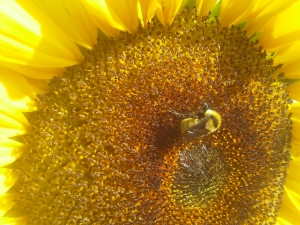
Adult bumble bees are large at roughly ¾ inch in length. They have black with yellow or orange colored hair patterns on their abdomen giving them a very fuzzy appearance. Both queens and workers have pollen baskets on their hind legs that are utilized in carrying pollen back to the nest. Females are capable of stinging, although they are rarely aggressive during foraging unless they feel threatened. Bumble bees, like honey bees are important pollinators. Workers use their long tongue to pollinate clovers and other flowers along with collecting pollen and nectar which they bring back to the nest for consumption by the colony. Foraging occurs only during daylight hours.
Fertilized queens are the only members of the colony that survive and overwinter. In the spring they emerge from their winter hiding and select a nest site in which they begin constructing the nest and raising workers. Nesting sites are typically close to the ground. Underground nests and abandoned rodent burrows are common nesting sites as well as in or under improperly sealed buildings. Nests may have several entrances and can reach 12 inches in diameter. Queens are responsible for laying eggs, which hatch into larvae and develop through instar stages prior to turning into a pupa. Many colonies contain a few hundred bumble bees; however, thriving colonies may contain upwards of 2,000 bees. Late summer broods contain both males and females for reproductive purposes. The colony will die off in the fall with the exception of fertilized queens.
Bumble bees insects can be deterred from nesting in or under buildings by sealing gaps and cracks in the foundation or around utility penetrations. Active nests that pose a threat due to stings should be treated by a well equipped professional in order to avoid being stung during treatment. It is not uncommon for some activity to continue for several hours after treatment as foraging bumble bees return to the nest. The area should be avoided until activity has stopped.